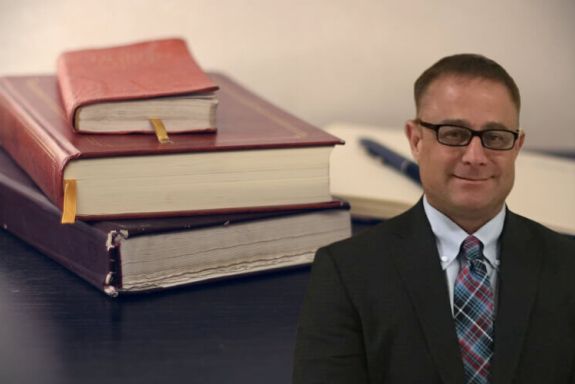

If we don’t win, you don’t pay.
NO WIN – NO FEE

ON CALL 24/7

U.S. Marine


The driver who causes a vehicle accident or the negligent landlord who left slippery liquid on the aisle floor is usually to blame for the incident. The injured motorist or slip-and-fall victim will file a claim against the at-fault party seeking compensation for damages, depending on the state of their own injuries suffered and how they were treated.
Only the at-fault driver was to blame in the above motor vehicle accident scenario example. But it’s not always so cut and dry. What if both drivers were to blame? This situation is modified, and pure comparative negligence enters the equation when the victim seeks damages.
Continue reading to learn more about comparative negligence states, their definition, different types, and comparative negligence examples, including modified contributory negligence, the pure comparative fault rule, and the pure contributory negligence rule.
This liability rule guide is intended to help whether you’re injured in pure comparative negligence jurisdictions, a modified contributory negligence state, or whether pure comparative negligence applies across the board. Since we are California-based attorneys, this article focuses heavily on California. We also distinguish a few other pure comparative negligence states to explain joint and several liability and the reasonable care legal rule.
Proving Car Accident Liability By Degree Of Fault Under California Negligence Law
Previously, we discussed personal injury protection proof and proving who must pay for their own negligence in a typical personal injury case. Most injury victims filing lawsuits over car accident negligence are entitled to recover damages for injuries.
This damaged party classification includes the person called a plaintiff. But the plaintiff has the burden to show that the defendant or defendants– the driver that caused the accident was negligent. Here we’ll specifically discuss the different types of set-offs that can make or break your case if the plaintiff’s negligence contributed to the plaintiff’s damages or worsened their injuries.
Below, we’ll use cutting-edge legal research and examples to show victims how insurance companies or a reasonable person on a jury determines fault in a car accident. We’ll also show you how a defense insurance adjuster or plaintiff’s attorney tries to determine fault during settlement negotiations. We’ll provide our training using case law and legal principles specific to traffic accidents under the contributory negligence system.
Statutory Negligence?
Negligence could be established as violating the CVC– the California Vehicle Code. But it could be due to the other driver’s behavior falling below the reasonable standard of care. So the plaintiff must prove the other driver failed to use appropriate methods while operating the vehicle.
Examples include Whitford v. Pacific Gas & Elec. Co. (1955) 136 Cal.App.2d 697. Because of that case, the injured party must show the other driver’s negligence was the cause of the plaintiff’s injuries and damages.
What Is Legal Liability Under California Law?
The defendant or defendants must have been negligent to be found liable for a car wreck, slip, and fall or any injury claim. Since most of the cases we handle involve fatal to severe car accidents, let’s look at negligence surrounding the operation, maintenance, or lending of a motor vehicle as an example.
First of all, people must behave reasonably. So there is a social responsibility to act intelligently. Most important for liability to attach is that the violation of your rights caused the personal injury. And these must be damages that can become quantified.
Proximate Cause In Automobile Accidents Explained
Case law holds that the accident must be the cause of your harm, as seen in Clarke v. Hoek (1985) 174 Cal.App.3d 208; Peter W. v. San Francisco Unified School District (1976) 60 Cal.App.3d 814.) Legal doctrines hold that the cause of the injuries must be the actual and “proximate cause.” So your wreck must be the “legal cause” of your injuries. If something else injured you, then the defendant is found to be not at fault. Get it?
Furthermore, this section of tort law mandates that the plaintiff shows the following:
- Defendant’s negligence was a contributing factor that caused the plaintiff’s injuries and damages, as seen in Sagadin v. Ripper (1985) 175 Cal.App.3d 1141; Gordon v. Havasu Palms 93 C.A.4th 244, 112 C.R.2d 816 (2001);
To escape liability, the defendant must prove the following:
The incident was not a substantial factor or foreseeable. Or the defendant must prove it was an independent intervening act that caused the plaintiff’s injuries or death.
Example: Mitchell v. Gonzales (1985) 54 Cal.3d 1041; “. . . negligence must be a substantial factor” in causing the plaintiff’s injuries.
What is Comparative Negligence
Comparative negligence, commonly known as comparative fault, is a legal concept in tort law that assigns blame to two or more parties according to the level of care each exhibited. In other words, if the harmed victim was partly responsible for their injuries through negligence on their part, the jury, judge, or insurance company will divide responsibility between them.
In a motor vehicle accident, the concept of comparative negligence comes into play when determining compensation. The assigned blame is utilized in comparative negligence to restrict the monetary amount of damages that a plaintiff can recover. For example, if the judge gives 80% responsibility to the defendant and 20% to the plaintiff, the plaintiff may only receive 80% of the damages.
Types of Comparative Negligence
In the United States, there are three types of comparative negligence:
Contributory Negligence
A contributory negligence defense states that the plaintiff cannot get compensation if they are even 1% at fault. In essence, if the plaintiff contributed in any way to the accident, they are not eligible for reparations. Only Alabama, the District of Columbia, Maryland, North Carolina, and Virginia recognize recovering lawsuit damages under contributory negligence.
Modified Comparative Negligence
Most North American U.S. courts use a modified comparative fault model. Here, the court will consider both plaintiff and defendant’s contributions to the incident in determining damages. But this is where it gets interesting for you and your lawyer trying to protect your insurance claim.
There are two distinct varieties of modified comparative negligence.
- 50% Bar Rule: The first is known as the 50% bar rule. In states following the 50% rule (including Colorado and Utah), a party that is 50% or more responsible for an accident may not recover any damages. (Plaintiff is barred from receiving financial support from insurers representing the other driver).
- Pure Comparative Negligence: Conversely, when compared to the 50 percent rule, pure comparative negligence allows a plaintiff to recover in more scenarios. Here, even a party 99% to blame for causing their car accident can still collect money damages for losses they did not cause. For example, if a drunk driver is mostly to blame for an accident, they may still receive compensation from another party who made the incident worse. (but in some states, the intoxicated motorist cannot sue for pain and suffering and might be denied insurance coverage based on unique circumstances.) The pure comparative negligence rule remains recognized in thirteen pure comparative fault states, including California, Florida, and New York.
Other Examples of Comparative Negligence?
Let’s say John is driving and makes an illegal U-turn at an intersection. While John makes the unlawful turn, Mike crashes into John because Mike blew through a stoplight during a “California Stop.”
John sustains injuries totaling $100,000, and Mike also sustains injuries totaling $100,000. After investigating the evidence, the jury assigns John 49% at fault and Mike 51% to blame for the motoring incident. How would the three types of comparative negligence jurisdictions apply the law here?
OUTCOME 1.
Contributory Negligence Jurisdiction Outcome?
Because John and Mike both played a role in causing the motor vehicle accident, neither can sue the other for damages. It’s likely they won’t be insured for property damage unless they purchased comprehensive, collision, and gap insurance coverage.
OUTCOME 2:
(California) Pure Comparative Negligence
Both Mike and John could collect some of their damages, according to the assigned blame. John would collect $50,100 (51% of his total damages), and Mike would collect $49,900 (49% of his total car crash damages).
Can You Get Paid Damages Even if You’re Also At Fault?
Yes, you can! Sometimes two or more acts or failures to act will combine in an accident. Unless the defendant had the last clear chance to avoid the wreck, some states would rule in the defendant’s favor. Case dismissed. But in California, we use pure comparative negligence rules. So here, your award is reduced based on your percentage of fault.
For example, A and B are in a car crash. A is following too closely and rear ends B. But imagine B exits the car in traffic. And then a CHP cruiser runs B over. So B dies. The jury would award the survivors of B for the vehicle damage and whiplash. But B’s estate would need to sue the CHP for the death.
However, getting out of a car in oncoming traffic would mean that B was partially at fault. Hence, under pure comparative negligence principles, the jury may find B 50% at blame, so if the court awards B $1 million against the CHP, the family would only get $500 thousand. Pure comparative negligence under state law says the plaintiff’s negligence offsets the plaintiff’s financial recovery amounts. The offset is based on the degree of negligence shown by the defendant.
This state has a pure form of comparative negligence – so even if the plaintiff has some fault, they can still recover for what they are not at fault. But your award gets reduced in proportion to degrees of responsibility, as seen in Li v. Yellow Cab Co. (1975) 13 Cal.3d 804.)
Here Are Some Scenarios That Include Negligence Under California’s Vehicle Laws:
Below, find a list of some typical cases of careless driver negligence for which damages could be recovered.
- Driving Too Fast – Driving way too fast can be negligent per se. (CVC Sec. 22350, et seq).; Hardin v. San Jose City Lines (1953) 41 Cal.2d 432). Sometimes it can be not very careful to drive too slowly. (Scott v Texaco, Inc. (1966) 239 Cal. App.2d 431.) Construction zone signs or hazard signs creating special speed zones remain disobeyed by many. And these are also a factor in proving negligence. (Wilding v. Norton (1957) 156 Cal. App.2d 374.)
- Failing to Pay Attention – Vehicle operators shall keep a proper lookout for other vehicles and people when driving on the roads and must control the car at all times so as not to cause a wreck. (Leeper v Nelson (1956) 139 Cal.App.2d 65; Lutz v. Schendel (1959) 175 Cal.App.2d 140).
- Failure To Yield Rights of Way – (CVC Sec. 21800, et seq.).
- Left turns (CVC Sec. 21801) see also Sesler v. Ghumman (1990) 219 Cal.App.3d 218; Failure to Yield to Right Of Way Signs (CVC Sec. 21803); Illegal U-Turn (CVC Sec. 22105.) At an intersection (CVC Sec. 21800(a)-(e), see also Saterlee v. Orange Glenn School Dist. (1947) 29 Cal.2d 581).
- Vehicle Defect – The owner or operator of a motor vehicle must inspect and maintain their car. (Yamaha Motor Corp. v. Paseman (1990) 219 Cal.App. 958; Dyer v. Superior Court (1997) 56 Cal. App.4th 61).
- Intentional and Reckless Acts – A motor vehicle operator cannot willfully harm people or property with the vehicle as a weapon or recklessly not do something they should have done! (Ingram v. Bob Jaffe Co. (1956) 139 Cal.App2d 193).
- Cannot Drive the “Wrong Way” – (CVC Sec. 21650); See also Altomare v. Hunt (1950) 101 Cal. App.2d 10).
- Illegal to Turn From A Wrong Lane – (CVC Sec. 22107).
- Must Maintain and Properly Use Your Vehicle Brakes – (Veh.C. 26450, et seq.; Maloney v. Rath 69 Cal.2d 442 (1968) 71 Cal. Reports. 897, 445 P.2d 513).
- Failure to Maintain or Turn on Your Headlights – (CVC Sec. 24400, et seq.; See also Matlock v. Farmers Mercantile Co. (1968) 258 Cal. App.2d 362).
- Failure To Give Proper Turn and Other Vehicle Signals – (CVC Sec. 22107-22111; Pittman v. Boiven (1967) 249 Cal. App.2d 207).
- Failure to Maintain Safe Following Distance- (Veh.C. 21703 Pittman v. Boiven (1967) 249 Cal. App.2d 207).
- Driving Under The Influence Of Alcohol or Drugs (“DUI”) (C.C. 3333.4(a)(1)).
Proving your car accident or other personal injury case is not as easy as it seems. It may require a trip to the accident scene to take pictures and collect witness statements about who contributed to the accident.
You may need to order a copy of the police report and subpoena videotapes from local stores and businesses to prove driving over the speed limit, reckless driving (driving drunk, road rage, etc.), or some other vehicle code violation.
It would be best to determine that the other driver failed to use reasonable attention/care while operating the vehicle. But some cases are more accessible to prove than others, especially in other states. Only then can you argue entirely the percentage of responsibility and how much the plaintiff should recover.
The above examples showed you the many possible scenarios in determining who’s at fault for the accident. Our lawyers feel pure comparative negligence is the best way to apportion blame to avoid harsh results, such as those caused under the auspices of the 51 percent rule. If you travel a lot and want to collect economic damages for your auto accidents from the other party, it’s essential to know these rules utilized by many states.
OUTCOME 3:
Modified Comparative Negligence
In a modified comparative negligence state, the 50% or 51% bar rule, Mike would not recover for damages since he was found 51% responsible. But John can still receive a total of $55,100, representing the portion of the accident history he didn’t cause.
If the judge found there to be a 50/50 liability split, Mike and John’s injury claims would neutralize each other’s. (neither part will contribute or receive) In that case, neither could collect monetary damages from the other.
However, in the unlikely scenario that a court found each party 50% liable, each party could hypothetically collect damages of $55,100 from each other for things like pain, suffering, or medical expenses.
Critical Things to Takeaway When You Seek to Collect Damages
- Comparative negligence assigns blame to the parties involved in an accident, such as when someone slams into your car on the road.
- Contributory, pure, and modified comparative negligence are the three primary types of comparative negligence.
- Most states use the modified comparative fault approach, with just thirteen states relying on pure comparative negligence, allowing recovery even if the plaintiff is found 99% at fault.
- In all three types of fault, you must understand your collectible money damages will be reduced by the portion of responsibility assigned to each party involved.
Ehline Law Firm Can Help You With A Comparative Negligence Case?
Yes, we can! If you’d like to learn more about each element of comparative fault and how it is considered when exercising your right to seek compensation, contact the Ehline Law Firm’s California personal injury lawyers immediately! Our team of legal experts has handled various vehicle accident cases and works hard to defend individual injury claimants’ rights. We provide a free consultation and only take our fully earned contingency fee if we win your case. With your consent, we will aggressively handle all aspects of your serious injury claims to ensure they are protected and covered under liability insurance during the entire insurance claims process.
-
Accordion - FAQs
Accordion - FAQs
- Can I Get More Money for Personal Injury With a Lawyer
- What Is A Personal Injury Lawsuit?
- What is The Civil Discovery Process?
- Bicycle Accident FAQs
- Minor’s Compromise FAQs
- What Should I Do If I’m Hurt Visiting or Vacationing in California?
- How Do I Enforce My Personal Injury Judgment?
- Are Fishing Expeditions Allowed At Depositions?
- Will My Legal Status Affect my Lawsuit?
- Pure Comparative Negligence Explained
- Determining Case Value
- How Do I Get A Rental Car After My Car Accident?
- How Much Money Do Personal Injury Lawyers Make?
- Los Angeles Car Accident Statistics | Safety, Tips and Data

